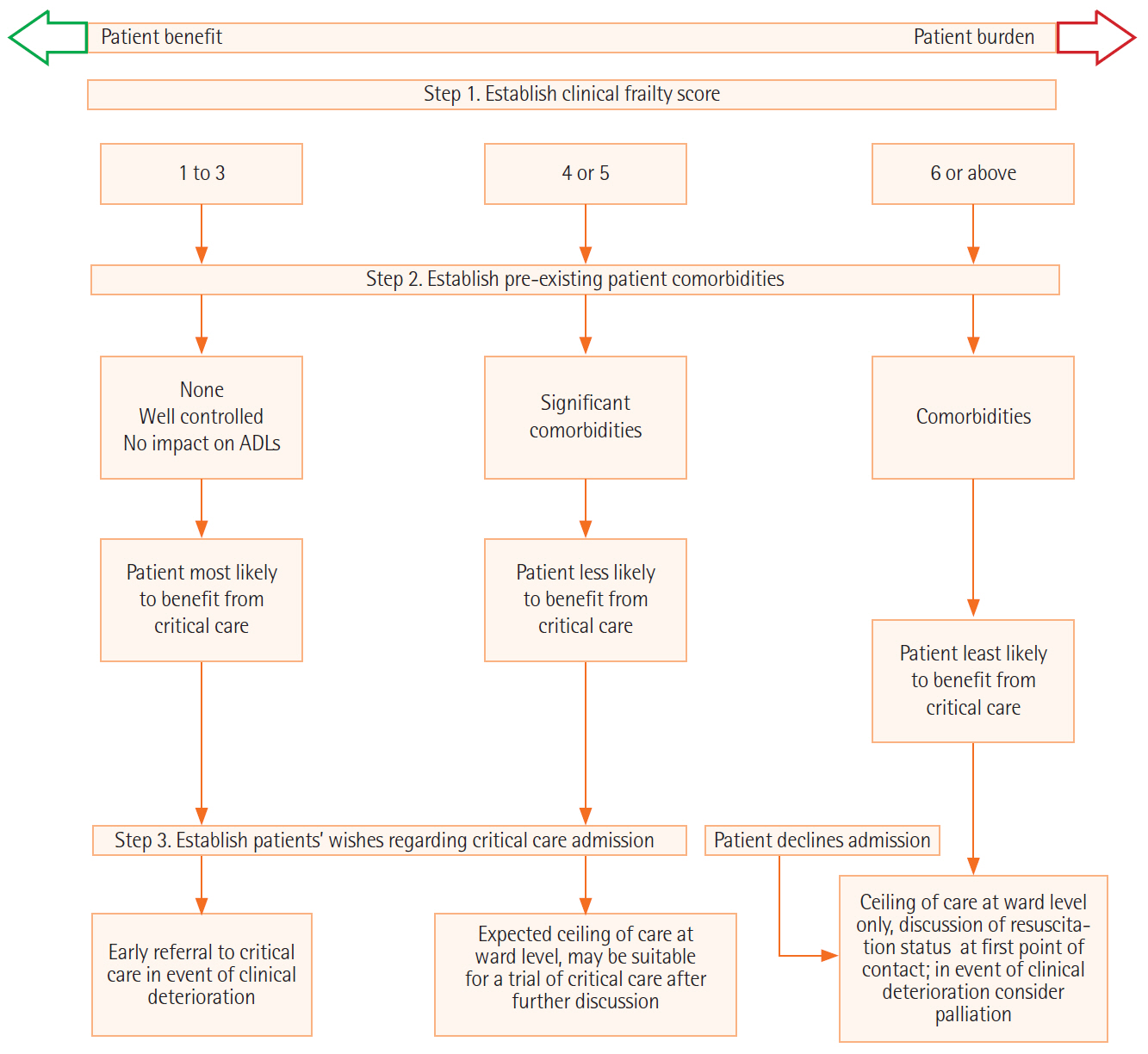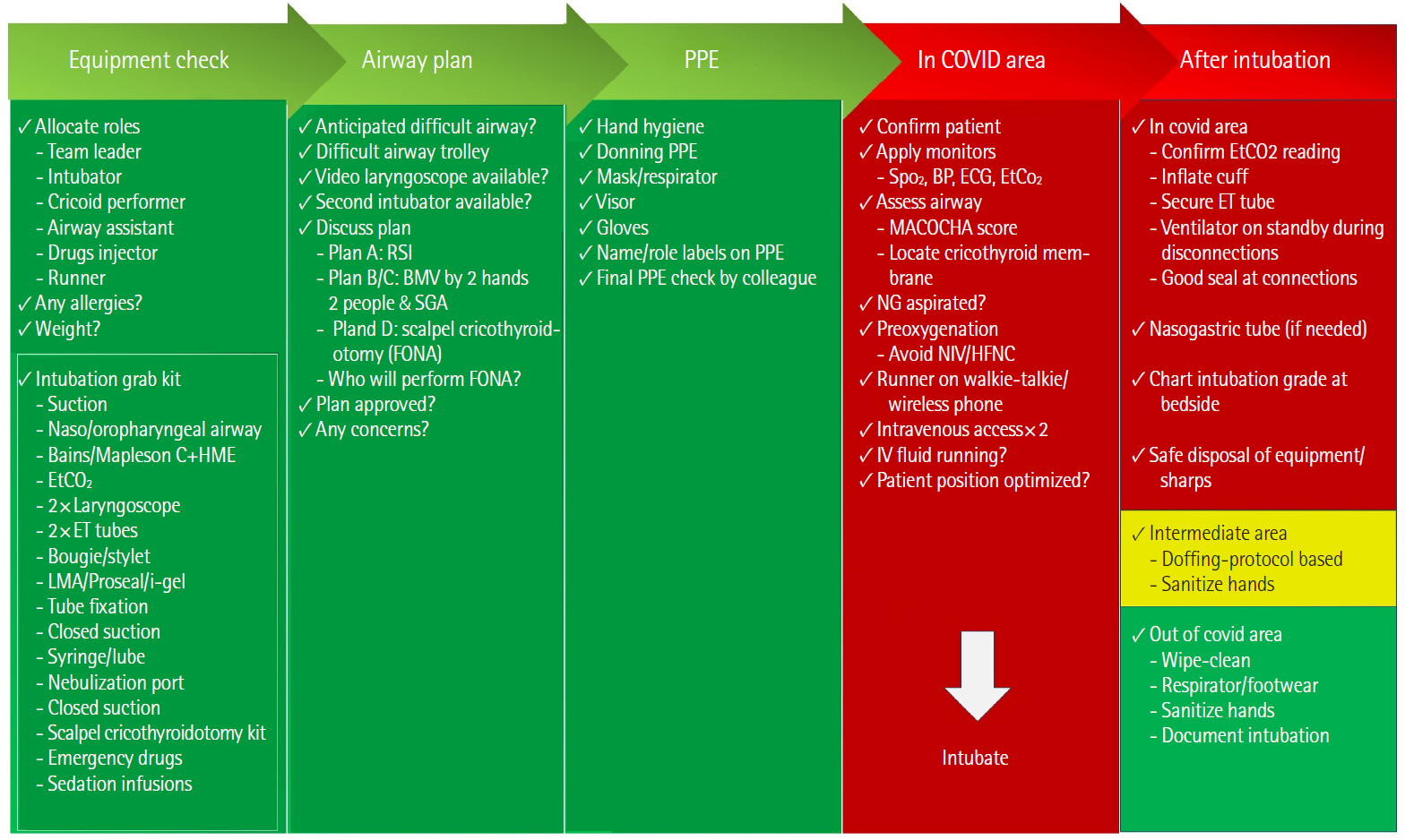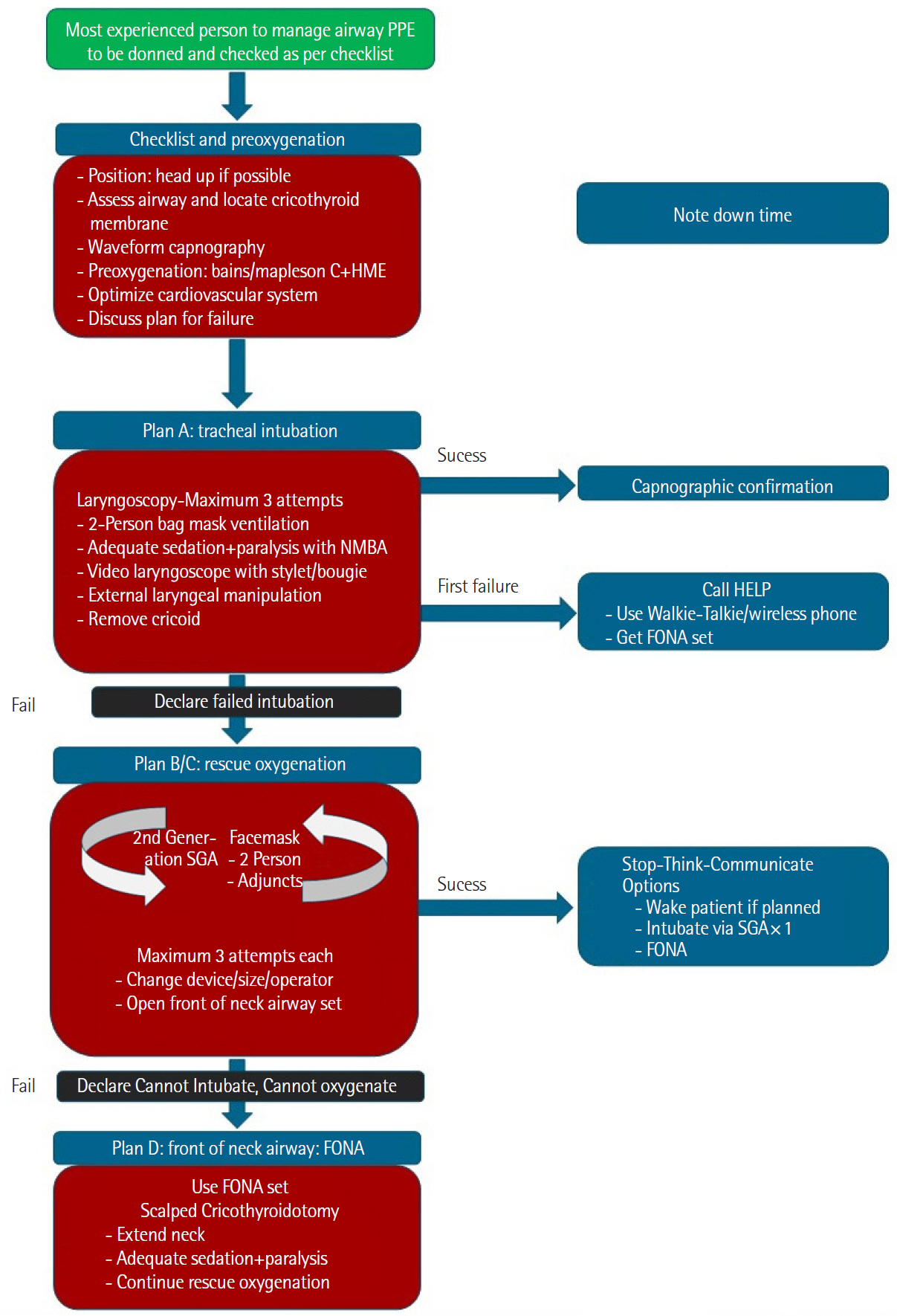Acute Crit Care.
2021 Feb;36(1):1-14. 10.4266/acc.2020.00864.
Evolution of COVID-19 management in critical care: review and perspective from a hospital in the United Kingdom
- Affiliations
-
- 1Critical Care Unit, Royal Preston Hospital, Preston, UK
- KMID: 2513248
- DOI: http://doi.org/10.4266/acc.2020.00864
Abstract
- The unexpected emergence and spread of coronavirus disease 2019 (COVID-19) has been pandemic, with long-lasting effects, and unfortunately, it does not seem to have ended. Integrating advanced planning, strong teamwork, and clinical management have been both essential and rewarding during this time. Understanding the new concepts of this novel disease and accommodating them into clinical practice is an ongoing process, ultimately leading to advanced and highly specific treatment modalities. We conducted a literature review through PubMed, Europe PMC, Scopus, and Google Scholar to incorporate the most updated therapeutic principles. This article provides a concise and panoramic view of the cohort of critically ill patients admitted to the intensive care unit. We conclude that COVID-19 management includes low tidal volume ventilation, early proning, steroids, and a high suspicion for secondary bacterial/fungal infections. Lung ultrasound is emerging as a promising tool in assessing the clinical response. Managing non-clinical factors such as staff burnout, communication/consent issues, and socio-emotional well-being is equally important.
Keyword
Figure
Cited by 1 articles
-
Comparison of characteristics and ventilatory course between coronavirus disease 2019 and Middle East respiratory syndrome patients with acute respiratory distress syndrome
Imran Khalid, Romaysaa M Yamani, Maryam Imran, Muhammad Ali Akhtar, Manahil Imran, Rumaan Gul, Tabindeh Jabeen Khalid, Ghassan Y Wali
Acute Crit Care. 2021;36(3):223-231. doi: 10.4266/acc.2021.00388.
Reference
-
1. Bamford P, Bentley A, Dean J, Whitmore D, Wilson-Baig N. ICS Guidance for Prone Positioning of the Conscious COVID-19 Patient 2020 [Internet]. London: Intensive Care Society;2020. [cited 2021 Feb 19]. Available from: https://www.ics.ac.uk/ICS/Pdfs/COVID-19/Guidance_for_conscious_proning.aspx.2. Caputo ND, Strayer RJ, Levitan R. Early self-proning in awake, non-intubated patients in the emergency department: a single ed’s experience during the COVID-19 pandemic. Acad Emerg Med. 2020; 27:375–8.
Article3. Gattinoni L, Chiumello D, Caironi P, Busana M, Romitti F, Brazzi L, et al. COVID-19 pneumonia: different respiratory treatments for different phenotypes? Intensive Care Med. 2020; 46:1099–102.
Article4. Eddleston J, Pittard A. Letter regarding the use of continuous positive airway pressure (CPAP) for COVID-19 positive patients [Internet]. London: Faculty of Intensive Care Medicine;2020. [cited 2021 Feb 19]. Available from: https://www.ficm.ac.uk/news-events-education/news/letter-regarding-use-continuous-positive-airway-pressure-cpap-COVID-19.5. Zhou F, Yu T, Du R, Fan G, Liu Y, Liu Z, et al. Clinical course and risk factors for mortality of adult inpatients with COVID-19 in Wuhan, China: a retrospective cohort study. Lancet. 2020; 395:1054–62.
Article6. Barrasa H, Rello J, Tejada S, Martin A, Balziskueta G, Vinuesa C, et al. SARS-CoV-2 in Spanish Intensive Care Units: Early experience with 15-day survival in Vitoria. Anaesth Crit Care Pain Med. 2020; 39:553–61.
Article7. Australian and New Zealand Intensive Care Society. The Australian and New Zealand Intensive Care Society (ANZICS) COVID-19 guidelines [Internet]. Camberwell: Australian and New Zealand Intensive Care Society;2020. [cited 2021 Feb 19]. Available from: http://cec.health.nsw.gov.au/__data/assets/pdf_file/0004/572512/ANZICS-COVID-19-Guidelines-Version-1.pdf.8. Difficult Airway Society. DAS ICU intubation guidelines [Internet]. London: Difficult Airway Society;2017. [cited 2021 Jan 25]. Available from: https://das.uk.com/files/2017/page/DAS_ICU_guidelines.pdf.9. Rello J, Storti E, Belliato M, Serrano R. Clinical phenotypes of SARS-CoV-2: implications for clinicians and researchers. Eur Respir J. 2020; 55:2001028.
Article10. Ferrando C, Suarez-Sipmann F, Mellado-Artigas R, Hernández M, Gea A, Arruti E, et al. Clinical features, ventilatory management, and outcome of ARDS caused by COVID-19 are similar to other causes of ARDS. Intensive Care Med. 2020; 46:2200–11.11. Calfee CS, Delucchi K, Parsons PE, Thompson T, Ware L, Matthay M, et al. Subphenotypes in acute respiratory distress syndrome: latent class analysis of data from two randomised controlled trials. Lancet Respir Med. 2014; 2:611–20.
Article12. Ai T, Yang Z, Hou H, Zhan C, Chen C, Lv W, et al. Correlation of chest CT and RT-PCR testing for coronavirus disease 2019 (COVID-19) in China: a report of 1014 cases. Radiology. 2020; 296:E32–40.13. Lichtenstein D. Lung ultrasound in the critically ill. Curr Opin Crit Care. 2014; 20:315–22.
Article14. Amato MB, Meade MO, Slutsky AS, Brochard L, Costa EL, Schoenfeld DA, et al. Driving pressure and survival in the acute respiratory distress syndrome. N Engl J Med. 2015; 372:747–55.
Article15. Bugedo G, Retamal J, Bruhn A. Driving pressure: a marker of severity, a safety limit, or a goal for mechanical ventilation? Crit Care. 2017; 21:199.
Article16. Sun X, Liu Y, Li N, et al. The safety and efficacy of airway pressure release ventilation in acute respiratory distress syndrome patients: a PRISMA-compliant systematic review and meta-analysis. Medicine (Baltimore). 2020; 99:e18586.17. Young D, Harrison DA, Cuthbertson BH, Rowan K; TracMan Collaborators. Effect of early vs late tracheostomy placement on survival in patients receiving mechanical ventilation: the TracMan randomized trial. JAMA. 2013; 309:2121–9.18. Robba C, Battaglini D, Ball L, Patroniti N, Loconte M, Brunetti L, et al. Distinct phenotypes require distinct respiratory management strategies in severe COVID-19. Respir Physiol Neurobiol. 2020; 279:103455.
Article19. Myatra SN, Monnet X, Teboul JL. Use of ‘tidal volume challenge’ to improve the reliability of pulse pressure variation. Crit Care. 2017; 21:60.
Article20. Tomazini BM, Maia IS, Cavalcanti AB, Berwanger O, Rosa R, Veiga V, et al. Effect of dexamethasone on days alive and ventilator-free in patients with moderate or severe acute respiratory distress syndrome and COVID-19: the CoDEX randomized clinical trial. JAMA. 2020; 324:1307–16.21. Angus DC, Derde L, Al-Beidh F, Annane D, Arabi Y, Beane A, et al. Effect of hydrocortisone on mortality and organ support in patients with severe COVID-19: the REMAP-CAP COVID-19 corticosteroid domain randomized clinical trial. JAMA. 2020; 324:1317–29.22. RECOVERY Collaborative Group, Horby P, Lim WS, Emberson JR, Mafham M, Bell LJ, et al. Dexamethasone in hospitalized patients with covid-19: preliminary report. N Engl J Med. 2020; Jul. 17. [Epub]. https://doi.org/10.1056/NEJMoa2021436.
Article23. WHO Rapid Evidence Appraisal for COVID-19 Therapies (REACT) Working Group, Sterne JA, Murthy S, Diaz J, Slutsky A, Villar J, et al. Association between administration of systemic corticosteroids and mortality among critically Ill patients with COVID-19: a meta-analysis. JAMA. 2020; 324:1330–41.24. Wang Y, Zhang D, Du G, Du R, Zhao J, Jin Y, et al. Remdesivir in adults with severe COVID-19: a randomised, double-blind, placebo-controlled, multicentre trial. Lancet. 2020; 395:1569–78.25. Grein J, Ohmagari N, Shin D, Diaz G, Asperges E, Castagna A, et al. Compassionate use of Remdesivir for patients with severe covid-19. N Engl J Med. 2020; 382:2327–36.
Article26. Boulware DR, Pullen MF, Bangdiwala AS, Pastick KA, Lofgren SM, Okafor EC, et al. A randomized trial of hydroxychloroquine as postexposure prophylaxis for covid-19. N Engl J Med. 2020; 383:517–25.
Article27. Cavalcanti AB, Zampieri FG, Rosa RG, Azevedo LC, Viega VC, Avezum A, et al. Hydroxychloroquine with or without Azithromycin in Mild-to-Moderate Covid-19. N Engl J Med. 2020; 383:2041–52.
Article28. WHO Solidarity Trial Consortium, Pan H, Peto R, Henao-Restrepo AM, Preziosi MP, Sathiyamoorthy V, et al. Repurposed antiviral drugs for covid-19: interim WHO solidarity trial results. N Engl J Med. 2021; 384:497–511.29. Interim position statement: interleukin-6 inhibitors (tocilizumab or sarilumab) for patients admitted to ICU with COVID-19 pneumonia (adults) [Internet]. Redditch: NHS England;2021. [cited 2021 Jan 20]. Available from: https://www.cas.mhra.gov.uk/ViewAndAcknowledgment/viewAttachment.aspx?Attachment_id=103715.30. Li L, Zhang W, Hu Y, Tong X, Zheng S, Yang J, et al. Effect of convalescent plasma therapy on time to clinical improvement in patients with severe and life-threatening COVID-19: a randomized clinical trial. JAMA. 2020; 324:460–70.31. Huet T, Beaussier H, Voisin O, Jouveshomme S, Dauriat G, Lazareth I, et al. Anakinra for severe forms of COVID-19: a cohort study. Lancet Rheumatol. 2020; 2:e393–400.
Article32. Thibodeaux K, Speyrer M, Raza A, Yaakov R, Serena T. Hyperbaric oxygen therapy in preventing mechanical ventilation in COVID-19 patients: a retrospective case series. J Wound Care. 2020; 29:S4–8.
Article33. Su H, Yang M, Wan C, Yi L, Tang F, Zhu H, et al. Renal histopathological analysis of 26 postmortem findings of patients with COVID-19 in China. Kidney Int. 2020; 98:219–27.
Article34. Becker RC. COVID-19 update: covid-19-associated coagulopathy. J Thromb Thrombolysis. 2020; 50:54–67.
Article35. Kotfis K, Williams Roberson S, Wilson JE, Dabrowski W, Pun BT, Ely EW. COVID-19: ICU delirium management during SARS-CoV-2 pandemic. Crit Care. 2020; 24:176.
Article36. Courcelle R, Gaudry S, Serck N, Blonz G, Lascarrou JB, Grimaldi D, et al. Neuromuscular blocking agents (NMBA) for COVID-19 acute respiratory distress syndrome: a multicenter observational study. Crit Care. 2020; 24:446.
Article37. Wendel Garcia PD, Fumeaux T, Guerci P, Heuberger DM, Montomoli J, Roche-Campo F, et al. Prognostic factors associated with mortality risk and disease progression in 639 critically ill patients with COVID-19 in Europe: Initial report of the international RISC-19-ICU prospective observational cohort. EClinicalMedicine. 2020; 25:100449.
Article38. Figliozzi S, Masci PG, Ahmadi N, Tondi L, Koutli E, Aimo A, et al. Predictors of adverse prognosis in COVID-19: a systematic review and meta-analysis. Eur J Clin Invest. 2020; 50:e13362.
Article39. Liang W, Liang H, Ou L, Chen B, Chen A, Li C, et al. Development and validation of a clinical risk score to predict the occurrence of critical illness in hospitalized patients with COVID-19. JAMA Intern Med. 2020; 180:1081–9.
Article
- Full Text Links
- Actions
-
Cited
- CITED
-
- Close
- Share
- Similar articles
-
- COVID-19 in children: reasons for uneventful clinical course
- COVID-19 Vaccination and Herd Immunity
- Unconventional Answers to Unprecedented Challenges: The Swedish Experience During the COVID-19 Outbreak
- COVID-19 and Aviation Medical Examination
- Outcomes of patients with COVID-19 requiring extracorporeal membrane oxygenation and continuous renal replacement therapy in the United States








